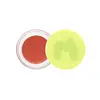Made by Mitchell Smoothie Stain Lip & Cheek Tint Versus Too Faced Cloud Crush Whipped Lip & Cheek Color
What's inside
What's inside
 Key Ingredients
Key Ingredients

 Benefits
Benefits

No benefits
 Concerns
Concerns

 Ingredients Side-by-side
Ingredients Side-by-side

Cyclopentasiloxane
EmollientIsononyl Isononanoate
EmollientDimethicone
EmollientStearoxymethicone/Dimethicone Copolymer
EmollientPhenyl Trimethicone
Skin ConditioningIsododecane
EmollientSilica
AbrasiveVp/Hexadecene Copolymer
Dimethicone Crosspolymer
Emulsion StabilisingCopernicia Cerifera Wax
Beeswax
Emulsion StabilisingCetyl PEG/PPG-10/1 Dimethicone
EmulsifyingSynthetic Fluorphlogopite
Calcium Sodium Borosilicate
Tocopheryl Acetate
AntioxidantCI 77891
Cosmetic ColorantCI 77492
Cosmetic ColorantTin Oxide
AbrasiveCI 45410
Cosmetic ColorantCI 15850
Cosmetic ColorantCyclopentasiloxane, Isononyl Isononanoate, Dimethicone, Stearoxymethicone/Dimethicone Copolymer, Phenyl Trimethicone, Isododecane, Silica, Vp/Hexadecene Copolymer, Dimethicone Crosspolymer, Copernicia Cerifera Wax, Beeswax, Cetyl PEG/PPG-10/1 Dimethicone, Synthetic Fluorphlogopite, Calcium Sodium Borosilicate, Tocopheryl Acetate, CI 77891, CI 77492, Tin Oxide, CI 45410, CI 15850
Dimethicone
EmollientDimethicone/Vinyl Dimethicone Crosspolymer
Skin ConditioningMethyl Trimethicone
Skin ConditioningPhenyl Trimethicone
Skin ConditioningPolyglyceryl-2 Triisostearate
EmulsifyingIsododecane
EmollientCetyl PEG/PPG-10/1 Dimethicone
EmulsifyingPentylene Glycol
Skin ConditioningSilica
AbrasiveSodium Hyaluronate
HumectantTocopheryl Acetate
AntioxidantRicinus Communis Seed Oil
MaskingCaprylyl Glycol
EmollientSilica Silylate
EmollientSorbitan Olivate
EmulsifyingCaproic Acid
CleansingParfum
MaskingBenzyl Alcohol
PerfumingCI 77891
Cosmetic ColorantCI 77491
Cosmetic ColorantCI 77492
Cosmetic ColorantCI 77499
Cosmetic ColorantCI 42090
Cosmetic ColorantCI 15850
Cosmetic ColorantCI 45410
Cosmetic ColorantCI 19140
Cosmetic ColorantCI 15985
Cosmetic ColorantDimethicone, Dimethicone/Vinyl Dimethicone Crosspolymer, Methyl Trimethicone, Phenyl Trimethicone, Polyglyceryl-2 Triisostearate, Isododecane, Cetyl PEG/PPG-10/1 Dimethicone, Pentylene Glycol, Silica, Sodium Hyaluronate, Tocopheryl Acetate, Ricinus Communis Seed Oil, Caprylyl Glycol, Silica Silylate, Sorbitan Olivate, Caproic Acid, Parfum, Benzyl Alcohol, CI 77891, CI 77491, CI 77492, CI 77499, CI 42090, CI 15850, CI 45410, CI 19140, CI 15985
Ingredients Explained
These ingredients are found in both products.
Ingredients higher up in an ingredient list are typically present in a larger amount.
This ingredient is a high molecular weight silicone. It has emulsifying and skin conditioning properties.
Ci 15850 is the pigment color red. It is an azo dye and created synthetically.
Azo dyes need to be thoroughly purified before use. This allows them to be more stable and longer-lasting.
This ingredient is common in foundations, lipsticks, and blushes. This color is described as brown/orangey red.
It has many secondary names such as Red 6 and Red 7. According to a manufacturer, Red 6 usually contains aluminum.
Learn more about CI 15850CI 45410 is a synthetic red-pigment and dye.
It often goes by both Red 28 or Red 27; manufacturers label both ingredients as CI 45410.
This dye is commonly found in makeup because it imparts a vivid color. Some types of this dye change color based on pH level and interaction with moisture:
Your skin has a natural pH of around 4.5 - 5.5.
According to the FDA, CI 45410 is not permitted for use in eye products.
Red 27 is a flourescein dye and commonly used as a fluorescent tracer in medicine.
Learn more about CI 45410Ci 77492 is also hydrated iron III oxide. It's sole purpose is to give a yellow hue to products.
Iron III oxides are classified as inorganic chemicals for coloring.
Synthetically created Ci 77492 is considered safer than those naturally found. This is because the synthetically created version may contain less impurities. Iron oxides are generally non-toxic and non-allergenic.
Learn more about CI 77492Ci 77891 is a white pigment from Titanium dioxide. It is naturally found in minerals such as rutile and ilmenite.
It's main function is to add a white color to cosmetics. It can also be mixed with other colors to create different shades.
Ci 77891 is commonly found in sunscreens due to its ability to block UV rays.
Learn more about CI 77891Dimethicone is a type of synthetic silicone created from natural materials such as quartz.
What it does:
Dimethicone comes in different viscosities:
Depending on the viscosity, dimethicone has different properties.
Ingredients lists don't always show which type is used, so we recommend reaching out to the brand if you have questions about the viscosity.
This ingredient is unlikely to cause irritation because it does not get absorbed into skin. However, people with silicone allergies should be careful about using this ingredient.
Note: Dimethicone may contribute to pilling. This is because it is not oil or water soluble, so pilling may occur when layered with products. When mixed with heavy oils in a formula, the outcome is also quite greasy.
Learn more about DimethiconeIsododecane is a fragrance, emollient, and solvent.
As an emollient, it helps your skin stay soft and hydrated. Emollients help trap moisture into your skin.
Isododecane's role as a solvent makes it a great texture enhancer. It spreads smoothly on skin and does not leave a sticky feeling behind. Isododecane also helps prevent color transfer in makeup products.
Isododecane is not absorbed into skin.
Learn more about IsododecanePhenyl Trimethicone is a silicon-based polymer. It is derived from silica.
Phenyl Trimethicone is used as an emollient and prevents products from foaming.
As an emollient, it helps trap moisture in the skin. It is considered an occlusive.
Learn more about Phenyl TrimethiconeSilica, also known as silicon dioxide, is a naturally occurring mineral. It is used as a fine, spherical, and porous powder in cosmetics.
Though it has exfoliant properties, the function of silica varies depending on the product.
The unique structure of silica enhances the spreadability and adds smoothness, making it a great texture enhancer.
It is also used as an active carrier, emulsifier, and mattifier due to its ability to absorb excess oil.
In some products, tiny microneedles called spicules are made from silica or hydrolyzed sponge. When you rub them in, they lightly polish away dead skin layers and enhance the penetration of active ingredients.
Learn more about SilicaTocopheryl Acetate is AKA Vitamin E. It is an antioxidant and protects your skin from free radicals. Free radicals damage the skin by breaking down collagen.
One study found using Tocopheryl Acetate with Vitamin C decreased the number of sunburned cells.
Tocopheryl Acetate is commonly found in both skincare and dietary supplements.
Learn more about Tocopheryl Acetate